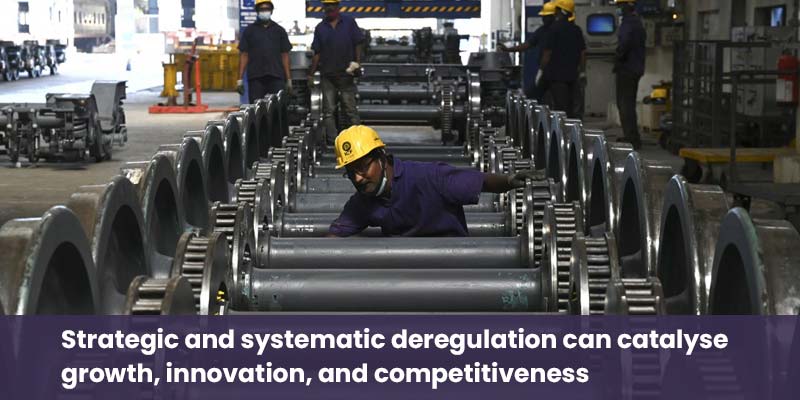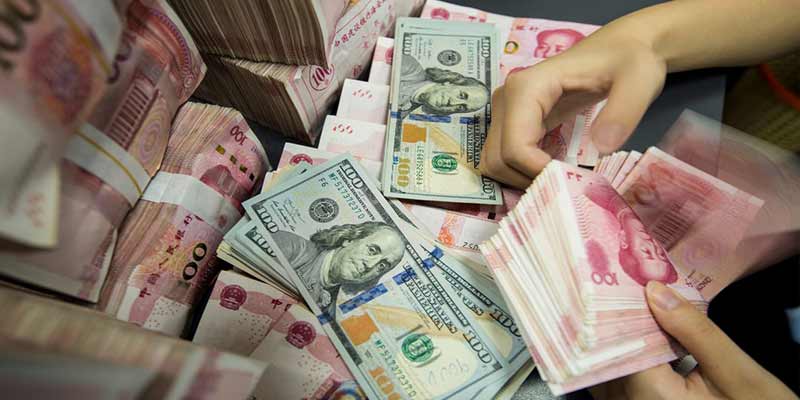- India
- Jan 31
What is ‘geo-economic fragmentation’?
• The Economic Survey 2024-25, tabled by Finance Minister Nirmala Sitharaman in Parliament on January 31, highlights the backsliding of economic integration with geo-economic fragmentation replacing globalisation.
• The decades since the 1980s witnessed significant globalisation, marked by remarkable shifts in global trade, investment, and economic activity.
• The global population grew from 4.4 billion in 1980 to eight billion in 2022, with urbanisation rates rising from 39 per cent in 1980 to 57 per cent in 2022, fuelling economic activity and connectivity.
• In 1980, global trade accounted for about 39 per cent of world GDP. By 2012, this share had risen to 60 per cent, reflecting the deep integration of global markets.
• Global Foreign Direct Investment (FDI) inflows grew from $54 billion in 1980 to over $1.5 trillion in 2019, showcasing the increasing role of multinational corporations in cross-border investments.
• The global economy grew from $11 trillion in 1980 to over $100 trillion in 2022.
• These statistics illustrate the profound changes globalisation has brought, driving economic integration and altering the global economic landscape.
• But, the next two decades are more likely to be about economic fragmentation.
• The global economy is at a significant juncture where long-held principles and practices are being re-evaluated and, in some cases, losing their relevance.
• Adding to this shift is China’s prominent role in global supply chains, which continues to reshape the economic landscape.
• As a result, many countries now operate in an environment markedly different from what they were accustomed to, with traditional rules being reconsidered and uncertainty surrounding what might replace them.
What is ‘geo-economic fragmentation’?
• ‘Geo-economic fragmentation’ can be defined as a policy-driven reversal of global economic integration often guided by strategic considerations. This process encompasses different channels, including trade, capital, and migration flows.
• Despite the benefits of integration, hyper-globalisation has also brought about associated complacencies. People have been left behind as industries have changed amid global competition.
• Rising geopolitical tensions and the breakout of war have further intensified these underlying fissures in the global economy.
• In a re-enactment of the Cold War era, countries are once again getting grouped into two blocs and phrases like friend-shoring have come to play centre-stage in global policy making.
• Tensions over trade, technology standards, and security have been growing for many years, undermining growth and trust in the current global economic system.
• Therefore, fragmentation — economic, social and cultural — is a direct consequence of the imposition of a ‘one-size-fits-all’ emission, as well as social and labour standards by western nations. These developments have growth implications.
• The nature and threat of geo-economic fragmentation are augmented by the fact that basic institutional structures that safeguard the principles of multilateralism also find themselves at a crossroads.
Rise in trade-restrictive measures
• The consequences and costs of geo-economic fragmentation are propagated via all the channels whereby countries engage with each other economically.
• Trade is the main channel through which fragmentation is reshaping the global economy. The capacity of trade to incentivise within-industry reallocation and generate productivity gains is getting increasingly stifled. This is most evident in the increase in the trade-restrictive measures imposed by countries.
• As per figures released by the World Trade Organisation (WTO) as part of the WTO Director-General’s annual overview of global trade developments, there is a sharp rise in the coverage of trade-restrictive measures by WTO members between mid-October 2023 and mid-October 2024, compared to the last Trade Monitoring Report in November 2023.
• As per estimates, the value of trade covered by the 169 new trade-restrictive measures introduced between October 2023 and October 2024 is $887.7 billion, which is half a trillion dollars more than the value of trade covered by restrictions introduced in the preceding year, which stood at $337.1 billion.
• The International Monetary Fund (IMF) observes that trade fragmentation is much more costly this time because, unlike the start of the Cold War when goods trade to GDP was 16 per cent, now that ratio is 45 per cent.
• Less trade implies less knowledge diffusion, a key benefit of integration, which could also be reduced by fragmentation of cross-border direct investment.
• One way to visualise trade restrictiveness is to quantify the trade coverage of new import-restrictive measures, apart from the number of restrictive measures presented earlier.
• Fundamental shifts in global economic engagement are underway with the proliferation of trade and investment restrictions. Between 2020 and 2024, over 24,000 new restrictions related to trade and investments have gone into place globally.
• The impact of this shift in global structural forces is reflected in global trade growth, which has slowed down significantly, and signs of secular stagnation in the global economy are beginning to emerge.
Relocation of FDI
• The impact of geo-economic fragmentation is seen in global FDI flows, which are increasingly concentrated among geopolitically aligned countries, particularly in strategic sectors. This relocation of FDI increases the vulnerability of several emerging markets and developing economies.
• The output losses associated with this FDI relocation emerging from friend-shoring and re-shoring are especially severe for emerging markets and developing economies. They face heightened restrictions from advanced economies, which are their major sources of FDI.
China gains strategic advantage
• China is a dominant force in the global manufacturing and energy transition ecosystems. It has gained a strategic advantage leveraging its competitiveness and economic policy to access and control key resources recognised today as critical for global supply chains.
• The effects of the rise of China as a manufacturing colossus are seen in automobile (especially electric vehicles) manufacturing, mining and refining capacity for critical minerals (copper, lithium, nickel, cobalt, graphite, etc) and in clean energy equipment, etc.
• China’s rise in the global auto market has disrupted the long-term incumbents in economies like Germany and Japan, and it dominates the global distribution of critical minerals and other economic resources, creating potential dependencies for posterity.
• Courtesy of these developments, the world’s modus operandi of outsourcing manufacturing to China pursued vigorously in the globalisation era is poised for a reset.
• Over the last decade, global solar photovoltaic cell (PV) manufacturing capacity has increasingly moved from Europe, Japan and the United States to China, which has invested more than $50 billion in new PV supply capacity — ten times more than Europe.
• About 60 per cent of the world’s wind installed capacity is sourced from China. China also houses nearly 80 per cent of the world’s battery manufacturing capacity, pivotal to the energy transition.
• On the solar front, China controls the supply of primary materials, manufacturing, installed capacity, and recycling capacity and produces at least 80 per cent of the main components of PVs.
• China’s vertical integration across the entire electric vehicle (EV) supply chain, from mining to EV manufacturing, has enabled it to retain its global dominance in this sector.
• It is also pertinent to note that about 70 per cent of the world’s rare earth minerals, which are critical resources for high-storage batteries, are processed by Chinese companies.
The need for amplifying deregulation agenda in India
• The global economy is now transitioning to a phase where the traditional, fundamental policy levers that were once effective may no longer be applicable or even relevant.
• Across the world, the focus of policy making globally has shifted inwards. The promise of shared benefits from a globalised world with open trade, free flow of capital and technology, and sanctity for rules of the game may be behind us.
• Amidst this new and emerging global reality, the best way to succeed with these structural reforms is to start relying on the internal engines and domestic levers of growth, focusing on a central element – the economic freedom of individuals and organisations to pursue legitimate economic activity.
• Unburdened by licensing, inspection and compliance requirements, the people and small enterprises of India, with their high aspirations and intrinsic inventiveness, will find answers to the pressing challenges of growth, employment and development.
• Lowering the cost of business through deregulation will make a significant contribution to accelerating economic growth and employment amidst unprecedented global challenges.
• Accelerating and amplifying the deregulation agenda already underway in the last 10 years is the need of the hour. Also, every state in the country can learn from the best practices of other states in different areas so that all progress in unison.
• Strategic and systematic deregulation can catalyse growth, innovation, and competitiveness.
• With deregulation, the Small and Medium Enterprises (SME) sector can help the states weather economic shocks, enable India to realise its manufacturing aspirations, attract long-term investments, and encourage growth.
• The current tendencies in the rest of the world necessitate that India redoubles its efforts to boost exports and attract investment.
• The need to find growth avenues in an export-challenged, environment-challenged, energy-challenged, and emissions-challenged world means we need to act on deregulation with a greater sense of urgency.
• The right balance of regulation and freedom can unleash the creative and productive capacities of India's small and medium entrepreneurs, leading to innovation, greater competition, and overall prosperity.
• By empowering small businesses, enhancing economic freedom, and ensuring a level playing field, governments can help create an environment where growth and innovation are not only possible but inevitable.
Manorama Yearbook app is now available on Google Play Store and iOS App Store




